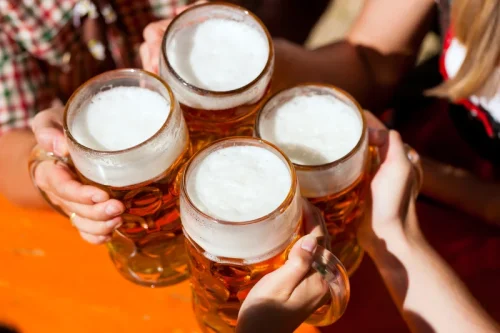
An intervention from loved ones can help some people recognize and accept that they need professional help. If you’re concerned about someone who drinks too much, ask a professional experienced in alcohol treatment for advice on how to approach Cure for Alcohol Withdrawal Symptoms that person. DTs usually last 2-3 days, but symptoms may linger for months in severe cases. A healthcare provider may request daily visits during which they will likely run blood tests and monitor vital signs until symptoms stabilize.
What helps with alcohol withdrawal at home?
Before you decide to go through alcohol withdrawal, write yourself a letter and keep it nearby for quick reference. The letter’s content should be encouraging and remind you why you are going through the challenge of detox in the first place. Pull the letter out and read it to yourself when you feel tempted. It’s even helpful to read it out loud, as this has been shown to help you retain the information more effectively. Keep a list of emergency phone numbers on hand that includes contact info for your doctor, the police, a nearby hospital, and someone you trust. And consider joining a support group such as Alcoholics Anonymous.

Behavioral Treatment
Find a supportive friend or family member to be with you while you withdraw and support your new non-drinking lifestyle. For people at low risk of complications, an office visit to your primary care provider, along with at-home monitoring and virtual office visits, may suffice. People at high risk of complications should enter a short-term in-patient detox program.
- The main management for severe symptoms is long-acting benzodiazepines — typically IV diazepam or IV lorazepam.
- We’ve tried, tested, and written unbiased reviews of the best online therapy programs including Talkspace, Betterhelp, and Regain.
- The severity of alcohol withdrawal is categorized into three stages.
- It’s rare for people going through alcohol withdrawal to experience hallucinations more than 48 hours after their last drink.
Medication for Alcohol Withdrawal
For most people, alcohol withdrawal symptoms will begin sometime in the first eight hours after their final drink. A rare but very serious syndrome called delirium tremens can occur during alcohol withdrawal. Also known as DTs, an estimated 2% of people with alcohol use disorder and less than 1% of the general population experience them. Healthcare providers typically prescribe short-term medications to relieve the symptoms of mild to moderate alcohol withdrawal. Alcohol withdrawal can deplete the body of essential nutrients.
Severe Symptoms
- Glutamate causes some common delirium tremens symptoms, such as a sudden, extreme spike in blood pressure, tremors, severe excitability, and seizures.
- They help lower activity in your CNS, which is the source of most of the dangerous problems with DTs.
- The main goal of treatment is to minimize your symptoms and prevent more severe ones like seizures or delirium, which could be fatal in some cases.
- The earlier a person gets treatment for DTs, the better the odds of survival and a positive outcome.
Let’s address some of the most frequently asked questions about alcohol withdrawal, providing insight into different aspects such as medication, home remedies, dietary considerations and more. Even with treatment, one of the possible complications of DTs is death. The risk of death is also higher if you have other severe medical conditions. The earlier a person gets treatment for DTs, the better the odds of survival and a positive outcome. Those with severe or complicated symptoms should be referred to the nearest emergency department for inpatient hospitalization.
Alcohol withdrawal delirium (AWD) is the most serious form of alcohol withdrawal. It causes sudden and severe problems in your brain and nervous system. Symptoms can range in severity, and it’s essential to have your symptoms evaluated by a medical professional. It’s important first to get evaluated by a medical professional and to reach out to a support system if you’re able. This could be family members, friends, members of your community, or people in sobriety support groups. The main goal of treatment is to minimize your symptoms and prevent more severe ones like seizures or delirium, which could be fatal in some cases.

Enhancing Healthcare Team Outcomes
Still, if you’re experiencing withdrawal symptoms, it’s essential to get evaluated by a healthcare professional. Depending on the severity of your symptoms, your doctor may recommend monitoring a medical setting or at home. Another alternative, especially if you have experienced severe withdrawal in the past, is to check yourself into a professional detoxification facility.

If your pattern of drinking results in repeated significant distress and problems functioning in your daily life, you likely have alcohol use disorder. However, even a mild disorder can escalate and lead to serious problems, so early treatment is important. If you are going to have delirium tremens, usually symptoms https://ecosoberhouse.com/ start between 2 and 4 days after your last drink. However, some symptoms may not show up until up to 10 days after you give up alcohol. There are a whole range of symptoms, including both physical and psychological issues. Once you have gone through withdrawal, you’ll also need a plan to remain alcohol-free.
Alcohol Withdrawal Syndrome: Symptoms, Causes, Treatment, and More
The medical professional who evaluated your AWS symptoms may suggest daily follow-ups via telephone or video chat to check on your symptoms and progress. The likelihood of developing alcohol withdrawal increases with the amount and frequency of your alcohol intake. Still, people experiencing these withdrawal symptoms are generally fully conscious and can think clearly. One advantage of in-patient detox is that you will be away from your usual drinking triggers and therefore be less likely to pick up a drink to stop symptoms when they begin. You do not have to have reached a crisis point to check into detox.
What food helps with alcohol withdrawal?
Try to mentally connect your alcohol consumption to pain, not pleasure or relief. Eating nutritious food, exercising, and getting enough sleep can help reduce some withdrawal symptoms, such as mood swings. If don’t have much of an appetite, you may want to take a multivitamin or drink a beverage high in electrolytes, such as a sports drink. If you take prescription medication, continue to take it as directed. Dietary guidelines recommend that if you drink, men limit daily drinking to two drinks or less per day and women limit their drinking to one drink or less per day.
